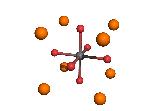
Strontium titanate is a functional ceramic with an extraordinarily large dielectric constant (nearly 300 at room temperature). It has a cubic perovskite structure, consisting of a simple cubic lattice of strontium atoms, with oxygen atoms in the face-centred cubic positions. These oxygen atoms form octahedra, with a titanium atom in the centre (in the body-centred cubic position).

The oxygen octahedra can easily rotate about the central titanium atom, giving rise to a host of possible distortions to the perfect crystal. At low temperatures the groundstate is an antiferroelectric phase, where alternate octahedra rotate in opposite directions. In addition to these spontaneous distortions, the oxygen octahedra can easily rotate in response to an applied electric field, or strain field.
Grain boundaries in the bulk give rise to a host of interesting distortions and properties, as well as providing a natural migration site for other impurities and defects. These properties can enhance or reduce the permittivity of the medium, and understanding their influence is crucial to a proper description of the behaviour of macroscopic samples.